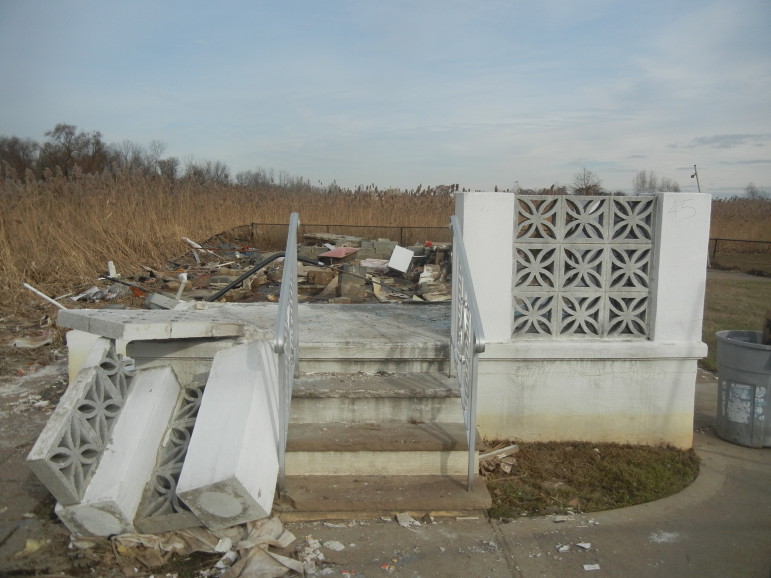In the decade since Superstorm Sandy made landfall in New York, the city has lagged in spending federal and capital funds dedicated to recovery and resiliency, a new report found. Some city agencies that received hefty federal grants related to Sandy have spent less than half of those dollars.

Jarrett Murphy
Damage from Superstorm Sandy in the Oakwood Beach area of Staten Island in 2012.In the decade since Superstorm Sandy made landfall in New York, the city has lagged in spending federal and capital funds dedicated to recovery and resiliency, a new report by City Comptroller Brad Lander shows. Furthermore, lack of transparency surrounding capital funding provided by the city has made it seem as though some projects are further along than they actually are, the report shows.
The city runs an online “Sandy Funding Tracker” that shows how much money has been spent so far on various ongoing projects. As of June, the city spent three-fourths of the $11 billion in federal grants received after the 2012 superstorm. But the progress report only accounts for federal dollars, not the city’s supplemental capital funding, the spending of which Lander’s office found to be lagging.
“When we did a deeper-dive analysis on some of the total project budgets and status of them, I was surprised to see how little has been spent in total, not just looking at the federal share, but also the date of completion that’s anticipated for some of these projects,” said Louise Yeung, the comptroller’s chief climate officer who authored the report.
She noted specifically that funding for an ongoing resiliency project in Hunts Point isn’t expected to be completed until 2030. “That’s almost 20 years after Sandy hit New York,” she said.
The recommendations will be factored into Mayor Eric Adams’ continued resiliency efforts, said City Hall Deputy Press Secretary Kayla Mamelak, adding that the administration recognizes the need to move quickly to protect the city. “New York City’s coastal resiliency projects lead the nation in complexity and size, but these projects take time to complete, and there is more work to be done,” said Mamelak.
Spending on other big-budget undertakings, like the East Side Coastal Resiliency project, which will add protective barriers along more than two miles of Manhattan’s eastern edge, is at just over 13 percent of its total $1.9 billion allocation. But the Sandy Funding Tracker shows that one-third of the $338 million in federal funds dedicated to the project has been spent—giving the appearance that progress is further along than it is.
Another project in Breezy Point was scrapped altogether after FEMA determined the intended flood mitigation would conflict with the city’s waterfront access requirements, Lander’s audit notes.
Some city agencies that received hefty federal grants related to Sandy have spent less than half of those dollars, according to the report. The Department of Transportation has allocated just under $67 million of the $142.3 million it received, and the Department of Correction, which received close to $89 million, has spent only about 45 percent.
“Unfortunately, evidence is that climate change is moving a lot faster than we are,” said Lander.
The report comes on the heels of a task force meeting, convened by Mayor Eric Adams, to reform the city’s process for completing capital projects. Lander, who serves on the task force, said he’s implementing a public-facing tracker on these projects to improve transparency around how and where the city’s funding is spent.
The tool, to launch next spring, is mandated by a local law Lander sponsored as a councilmember that passed in 2020.
Liz Donovan is a Report for America corps member.








